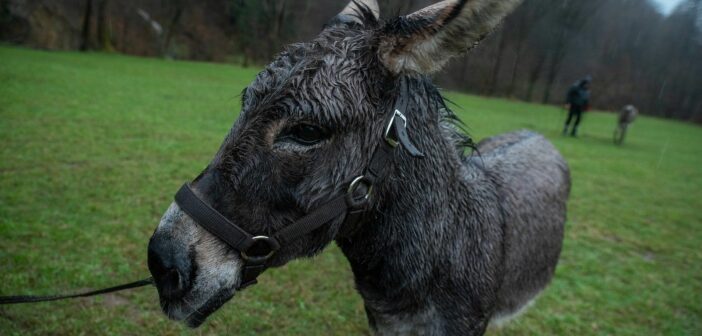What would life look like through the eyes of a donkey? 'EO' offers a thrilling account of one donkey's journey through modern Europe - from a Polish circus, to a slaughterhouse, to a wealthy Italian courtyard - Skolimowski pushes animal rights activism towards centre stage.
-
9
Viewed on Saturday 28 May as press for the Cannes Film Festival 2022.
Red and black. Blurred, distorted. A donkey and a woman. Going round in circles. Birdseye view, until the letters ‘E’ and ‘O’ flash intermittently. Jerzy Skolimowski’s EO (2022) opens with its titular donkey performing in a Polish circus, pre-empting his spiralling through life’s troughs and peaks of utter bliss and miserable despair in this realistic depiction of animal love and cruelty. Cinematographer, Michal Dymek, captures the immense heart of stories that follow an animal protagonist. Camera angles are low, lighting is often distorted, all to accurately, and effectively, portray the captivating perspective of a donkey and the inhumane treatment propelled by the entertainment and meat industry. Disney’s Dumbo (1941) and, more recently, Bong Joon-ho’s Okja (2019) are notable entries that rely heavily on animation or CGI. However, costume designer, Katarzyna Lewinska, dazzles EO with her minimal practical effects and poignant use of live animals.
If you’re expecting a coherent, traditional narrative in EO, you’ll find yourself disappointed. Instead, Skolimowski tells a travel narrative; delocalised; unstable; forever fluid in its exploration of the human-animal connection and sheer willpower to live peacefully. Jarring in his journey through modern Europe, EO meets the good and the bad of humanity, living pockets of short dramas from football hooligans, slaughterhouses, petrol station crime, and wealthy Italian courtyards.
From Sandra Dryzmalska’s circus-performer-maternal-owner, Kasandra, we encounter Mateusz Kościukiewic’s blasé Mateo and Isabelle Huppert’s erratic Countess, his mistress, and step-mother. Skolimowski’s isolated stories are mutually-exclusive, yet strangely connected. The audience and EO, ultimately, become one as the spectator; helpless in changing the narrative and first-hand witnesses to the cruel forces of nature EO endures. As we travel from story to story, Pawel Mykietyn’s moody orchestral score rhythmically binds them together as one musical piece, crescendoing in EO’s admittedly bleak climax and denouement.
At a run-time of eighty-eight minutes, EO left me wanting for more. I had fallen in love with a donkey who hadn’t even spoken a single word. His story is told through the actions of other characters, his happiness and immense pain pouring out in merely the close-ups of his eyes. One thing is for sure, Skolimowski’s genius storytelling technique made me contemplate my own relationship with animals. Skolimowski demonstrates that animals are sentient beings, yearning for a compassionate and sustainable relationship with humans.
EO is certainly a must-see for those who wish to experience an othering, unique, cinematic experience.




